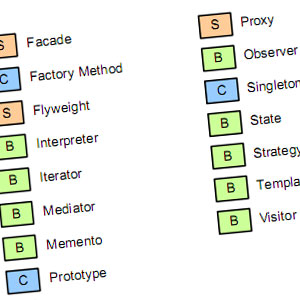Design Patterns: The building blocks of successful software development
Published

Software development is a complex task where it is important to apply best practices and patterns to develop efficient and maintainable solutions. In this article, we'll look at design patterns, the proven building blocks used in software development to solve common problems. We will understand what design patterns are and how they can help develop high quality software.
What are Design Patterns?
Design patterns are proven solutions to recurring problems in software development. In this section, we will understand the basics of design patterns and learn about different categories of design patterns, including generation patterns, structural patterns, and behavioral patterns.
Advantages of Design Patterns

Those : jtmmartins.github.io
Design patterns offer a number of advantages in software development. In this section, we will learn about the various benefits of design patterns, including improved maintainability, code reusability, flexibility, extensibility, and simplified communication between developers.
Generation pattern
Creation patterns are design patterns that deal with the creation of objects. In this section, we will learn about some important creation patterns such as the Singleton pattern, Factory pattern, and Builder pattern. We will understand when and how these patterns can be applied to optimize the creation of objects.
Structural pattern

Those : kariera.future-processing.pl
Structural patterns deal with organizing classes and objects to form larger structures. In this section, we will learn about some structural patterns such as the Adapter pattern, Decorator pattern, and Composite pattern. We will understand how these patterns can be used to improve the structure and collaboration of classes and objects.
behavior patterns
Behavior patterns deal with the behavior of objects and how they communicate with each other. In this section, we will learn about some behavior patterns such as the Observer pattern, the Strategy pattern, and the Command pattern. We will understand how these patterns can be used to flexibly customize the behavior of objects and improve the interaction between them.
Best practices for using design patterns

Those : code.tutsplus.com
Design patterns can be powerful tools, but it's important to use them wisely. In this section, we will learn some best practices for using design patterns, including choosing the right pattern, clarity in implementation, documentation, and continuous design improvement.
Summary
Design patterns are the building blocks of successful software development. They offer proven solutions to common problems and improve the quality, maintainability and flexibility of software solutions. By understanding and applying design patterns, developers can develop more efficient and robust software. In this article, we learned the basics of design patterns and examined different categories of design patterns, including generation patterns, structural patterns, and behavioral patterns. We also discussed the benefits of using design patterns, such as improved maintainability, code reusability, and simplified communication between developers. In addition, we have introduced some important design patterns in each category and explained their use cases. It is important to note that design patterns are tools and should not be viewed as rigid rules. They serve as guidance and offer proven solutions, but can be adapted depending on requirements and context. A good developer knows different design patterns and knows when and how to apply them. The use of design patterns requires experience and practice. By studying and applying design patterns, developers can expand their skills and build a solid foundation for developing high-quality software. It is also important to stay abreast of new design patterns and developments in the software industry to keep up with current best practices. Overall, design patterns are a valuable tool in software development. They enable developers to develop effective solutions to recurring problems and create high-quality software. By understanding and applying design patterns, we can improve our code and increase the efficiency of our development processes.








